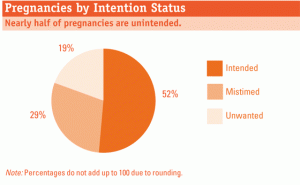Unintended Consequences
Oct 27th, 2013 | By admin | Category: Family PlanningBy Suzanne York, www.howmany.org
As the United States is recovering from the government shutdown and the still-ongoing battle over the Affordable Care Act, which was legally passed by Congress, it is worthwhile to note the state of healthcare as it applies to reproduction and the rights of women.
The Guttmacher Institute recently came out with some useful and interesting statistics on unintended pregnancies in the U.S. Public expenditures on these births—including costs of prenatal care, labor and delivery, postpartum care and one year of care for the infant—totaled $12.5 billion in 2008.
Nationally, two out of every three births resulting from unintended pregnancies, approximately 1.1 million births, were paid for by public insurance programs in 2008, according to the report “Public Costs from Unintended Pregnancies and the Role of Public Insurance Programs in Paying for Pregnancy and Infant Care.”
See a factsheet on unintended pregnancies here.
Below are some statistics from a Guttmacher email update (dated October 22):
- Nationally, 65% of the 1.7 million births resulting from unintended pregnancies in 2008 were paid for by public insurance programs (Medicaid, the Children’s Health Insurance Program and the Indian Health Service), compared with 48% of all births and 36% of births resulting from intended pregnancies.
- There were 2.0 million publicly funded births in 2008; of those, 1.1 million, or 53%, resulted from unintended pregnancies; by comparison, 1.7 million out of 4.2 million births nationwide—39%—resulted from unintended pregnancies.
- In 15 jurisdictions, at least 70% of births resulting from unintended pregnancies were paid for by public programs. Mississippi was the state with the highest proportion (83%). All but three of those 15 jurisdictions are in the South (as categorized by the U.S. Census Bureau), a region with high levels of poverty.
- Of the $12.5 billion in government expenditures on births resulting from unintended pregnancies in 2008, $7.3 billion were federal expenditures and $5.2 billion were state expenditures.
- In seven states, public costs related to births from unintended pregnancies exceeded half a billion dollars. California ($1.5 billion) and Texas ($1.3 billion) spent the most.
The authors of this report warn that chronic underinvestment and ideological attacks on the programs and providers that make publicly supported family planning services accessible to millions of women have been counterproductive. For instance, appropriations for the Title X national family planning program are 67% lower today than they were in FY 1980, adjusted for inflation.
Ultimately, the report concludes that shortsighted cuts to highly successful family planning programs may actually end up increasing public expenditures.
People and politicians need to understand the costs of unintended pregnancy, and this includes not just the financial aspects but the emotional aspects too. It shouldn’t be about money, but that is the language most politicians relate to. Behind these numbers though, are pictures of average women and men, and turning the focus from budget battles to improving lives should be the priority.
Suzanne York is a senior writer with the Institute for Population Studies.
[photo credit: journalistresource.org]


